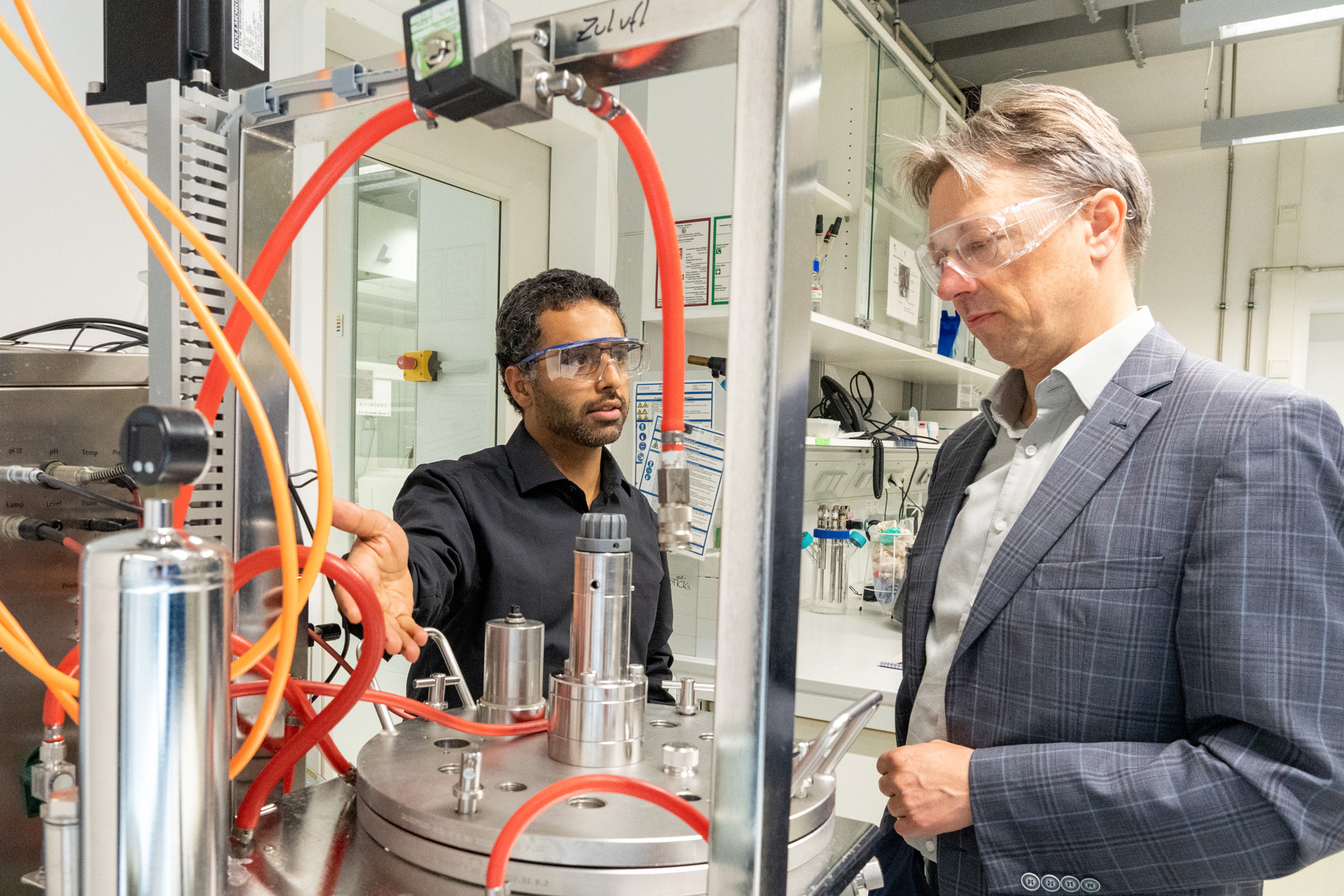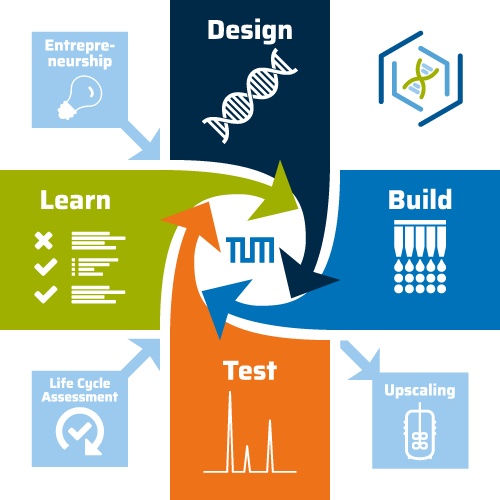2020–2025
Sustainable construction is one of the major challenges of our time. In addition to the current energy transition, efforts in the raw materials transition are therefore being intensified. Thermal insulation materials play a central role in this.

Goal
The aim of the project is to manufacture a product for thermal insulation in the construction sector from hardwood particles and fibres using previously unproven methods for foaming while simultaneously improving fire protection and microbial stability. The Department of Organic-Analytical Chemistry is focussing on the catalytic synthesis of new silicon compounds. These are to be used as additives for the hydrophobisation of cellulose. The largely unknown substance class of bis(triorganosilyl)carbonates can release CO2 in addition to the silanisation of the hydroxyl groups in order to initiate foaming. By varying the residues, it is possible to customise the properties of the additive. For example, derivatives with oligomeric silanes as residues can produce hydrophobic surfaces very quickly. These promising possibilities call for a synthetically efficient route that enables industrial relevance and further research into the substance class.
Methods
The following approaches are intended to deliver results for the project and solve key problems:
- Organic catalytic synthesis of silicon additives for the silanisation of wood fibres
- Application of alternative foaming processes for the production of porous materials
- Production of suitable test specimens for mechanical testing
- Further testing of optimised samples for fire behaviour and insulation properties by a laboratory to be commissioned
- Documentation of the material and energy balance of the raw materials and processes used
- Derivation of carbon balances to compare the climate protection contribution of conventional insulation materials such as Styrodur®
Additional images
Project duration
2021-04-15 – 2024-07-16
Involved Personnel
Project Coordination
Project Executives

Project Partner
Funding
Funding program “Nachwachsende Rohstoffe" of the Bundesministerium für Ernährung und Landwirtschaft (BMEL, Federal Ministery of Food and Agriculture)
- Funding ID
- 987654321
- Total funding amount
- 1,000,000.00 Euro
- Project share
- 500,000.00 Euro
Hemp, with its many uses, should be cultivated more frequently again, as this expansion of the crop spectrum can strengthen biodiversity. Innovative hemp products such as CBD extracts create new opportunities for value creation in rural areas. The project will develop specific recommendations for sustainable cultivation and the achievable qualities and yields for the various utilisation paths. Advice is needed on the choice of variety, sowing density and timing, harvest date and nitrogen requirements. The legal situation and the market situation are also determined on an ongoing basis and passed on in the advisory service.
Target
One of the objectives of the project is to determine the correct fertiliser requirements of hemp for the various uses. The previous values in the "Yellow Booklet" are outdated and only designed for fibre use. By revising them, groundwater can be protected and unnecessary amounts of fertiliser can be saved. With concrete recommendations on sustainable cultivation and the achievable qualities and yields, the presentation of the various utilisation options and up-to-date contact lists for processors and equipment rental companies, the project aims to create the necessary decision-making basis for further cultivation of this beneficial crop.
Method
As part of the project, important research questions on hemp cultivation, utilisation directions and market potential are determined using the following approach:
- Clarification of production-related questions depending on the direction of use and possibilities of mechanical weed control in grain hemp
- Examination of the site conditions
- Ecological assessment, particularly with regard to water protection
- Development of specific variety recommendations depending on the direction of use and crop rotation
- Display of possible utilisation variants and linkage utilisation
- Networking to provide contacts to processors, rental options for harvesting equipment and information on the legal situation
- Presentation of findings at the annual TFZ field day and through information material
Project duration
2020-01-01 – 2022-12-31
Involved Personnel
Project Coordination
Project Partner
Funding
Bayerisches Staatsministerium für Ernährung, Landwirtschaft und Forsten (StMELF)
- Funding ID
- G2/N/19/07
The occurrence of neurodegenerative diseases is closely linked to advancing age. The preparations currently on the market for the treatment of diseases such as Alzheimer's or Parkinson's serve to combat symptoms and cannot stop the disease itself. Novel therapeutic approaches are aimed at activating the regeneration of the affected area by administering special substances. Some secondary plant constituents of hops show interesting effects in vitro with regard to the regeneration and new formation of nerve cells and may therefore be suitable for use in regenerative medicine. Studies on market and consumer behaviour with regard to herbal medicinal products have shown that there is a general consumer interest in innovative plant-based medicinal products and that they are also interested in hop-based products.
The aim of the project is to generate an expanded sales market through a new product for hop-processing companies in Bavaria. One sub-goal is the further development of a special, patent-pending method for obtaining valuable neuroactive hop extracts on a pilot scale. To this end, a special extract will be produced from a hop processing residue that has been used as animal feed to date, which is to be used in phytopharmaceuticals. To this end, a product concept for such a phytopharmaceutical is to be developed and tested that takes into account the early stage of development and the inherent risks.
Project duration
2019-10-01 – 2022-09-30
Involved Personnel
Project Coordination
Project Executives
Funding
StMELF Bayern
The aim of this project is to research blue-green algae as a starting point for high-quality products using cultivated biomass. For this purpose, lynbyatoxins are specifically modified using metal-catalysed diene metathesis. Metathesis increases the lipophilicity of these substances. Lyngbyatoxins are generally regarded as neurotoxic compounds that easily cross the blood-brain barrier. The substances are analysed for their neurotoxicity and differentiation potential using bioactivity tests.
Project duration
2017-01-01 – 2020-12-31
Involved Personnel
Project Coordination
Project Executives
Dr. Corinna Urmann
Professorship Organic Analytical Chemistry
- Head of the Natural Products Department
Funding
Project duration
2016-01-01 – 2020-12-31
Involved Personnel
Project Coordination
Project Executive
Funding
2015–2020
The aim of this project is to research blue-green algae as a starting point for high-quality products using cultivated biomass. For this purpose, lynbyatoxins are specifically modified using metal-catalysed diene metathesis. Metathesis increases the lipophilicity of these substances. Lyngbyatoxins are generally regarded as neurotoxic compounds that easily cross the blood-brain barrier. The substances are analysed for their neurotoxicity and differentiation potential using bioactivity tests.
Project duration
2017-01-01 – 2020-12-31
Involved Personnel
Project Coordination
Project Executives
Dr. Corinna Urmann
Professorship Organic Analytical Chemistry
- Head of the Natural Products Department
Funding
Project duration
2016-01-01 – 2020-12-31
Involved Personnel
Project Coordination
Project Executive
Funding
Hops were named medicinal plant of the year in 2007. The cultivated plant is commonly known for its use in the brewing industry, but has also been documented as a medicinal plant for around 1000 years. A total extract is usually used for phytopharmaceutical preparations, as there is a lack of information on the active substances for treating nervous agitation and mild depression.
Currently, depression is associated with a decline in the formation of new nerve cells in certain areas of the brain. A state-of-the-art therapeutic approach therefore aims to stimulate the formation of new nerve cells from the body's own adult stem cells. Cell-based studies have identified a group of substances in hops that initiate specialisation into nerve cells. In addition, a method was developed to obtain a special extract with a higher concentration of active ingredients. Such extract preparations put the use of hops on an innovative footing, as they could be used to treat many neurodegenerative diseases.
The overall objective is therefore to clarify the suitability of such special extracts with regard to phytopharmaceutical application (standardisation of the production process, biological activity, consumer acceptance). Reliable therapeutic results can only be achieved if, in addition to batch conformity, extract production is also standardised. In addition to the optimisation and standardisation of the process, the active ingredient content in different hop varieties will be examined. Furthermore, the biological activity of the extracts is determined by pharmacological tests in the field of neurodegenerative diseases. The combination of the data on the process, the economic efficiency and the potential effect provides information on the suitability of the production process. In addition, a possible use in phytopharmacy also depends on the acceptance by the consumer (target group 30+). Health aspects play an important role for this group, as they are in their most productive phase of life, but are increasingly affected by initial illnesses due to stress factors.
Project duration
2015-03-01 – 2018-08-31
Involved Personnel
Project Coordination
Project Executives
Funding
BMBF
In Germany, grassland accounts for about one third of the agriculturally used area and is thus a significant part of our cultural landscape. In addition to the use of green waste as animal feed, the use of these areas for the cultivation of renewable raw materials is becoming increasingly important.
In a joint project with the Straubing Science Centre, the farm biorefinery is to be used to develop a plant that makes special use of grass and grass silage as raw materials. In a modular and decentralised small plant, gaseous olefins such as ethene or isoprene are to be obtained from the biomass by fermentative digestion and conversion processes. These in turn are to be used as starting materials for other valuable products such as fuels. This is the main difference between the farm biorefinery and the biogas plant, whose product methane is so largely inert that it is not suitable for further chemical utilisation.
The aim of this subproject is the catalytic conversion of biotechnologically produced ethylene into liquid energy sources. As a gas, it can be easily separated in the preceding production step and then oligomerised into short-chain hydrocarbons with about 6-18 carbon atoms. Depending on the chain length and degree of branching, the product can be used as diesel or gasoline, but longer-chain molecules are no longer suitable for these fuels due to their excessively high boiling point.
For this purpose, a cost-effective catalyst is to be developed that operates under the mildest possible conditions and is highly resistant to impurities. The aim is also to ensure that the plant is operated as maintenance-free as possible and that high catalytic productivity is achieved in order to guarantee long production cycles. The catalysts used will be based on large-scale processes such as the Shell Higher Olefin process, but adapted to the milder conditions and smaller scale of the farm biorefinery.
The focus is on organometallic nickel complexes with bidentate P,O or N,O chelating ligands. The properties of the catalyst are significantly influenced by their size, structure and substitution pattern. Above all, the degree of oligomerization is a decisive parameter, since both short-chain and long-chain molecules are unsuitable for use as fuel. The coligands used, especially various phosphines, also play an important role here.
Initially, the catalysts are used in a homogeneous solution and the products are separated by distillation. In the further course of the project, a reactor prototype will also be developed and the process heterogenized by applying the catalyst to an inert carrier material.
Project duration
2013-01-01 – 2016-12-31
Xanthohumol, the highly concentrated prenyl flavonoid in the hop plant, is converted into flavanone isoxanthohumol during the brewing process. The most highly concentrated prenylflavanones in beer are therefore isoxanthohumol and 6 prenylnaringenin. Since isoxanthohumol is metabolized to 8 prenylnaringenin in the body and 6-prenylnaringenin is directly ingested, these substances ingested by beer were examined for their biological activities such as neurogenesis-inducing and anti-cancerogenic activity. Both compounds show differentiation-inducing activities on neuronal stem cells and have been identified as HDAC (histone deacelyase) inhibitors.
In order to have an effect on the neuronal stem cells in the brain, the substances have to cross the blood-brain barrier. Consequently, the penetration of the two flavonoids 6 prenylnaringenin and 8 prenylnaringenin through the blood-brain barrier will be investigated in a model system.
Project duration
2015-01-01 – 2015-12-31
Involved Personnel
Project Coordination
Funding
Scientific Station for Breweries in Munich e.V.
The material class of polyamides is characterized by the repeating carbonamide group in the main chain, which is responsible for the physical differences compared to most other polymeric materials. The formation of hydrogen bonds by the carbonamide function contributes to the outstanding mechanical properties, chemical resistance and water absorption capability of polyamide materials.
Various methods are known for the production of polyamide monomers from petrochemical sources. As in many other areas, the synthesis of polyamide monomers attempts to replace or supplement these petroleum-based raw materials with renewable ones. In this project, aliphatic, unsaturated fatty acids will serve as starting materials. Oleic acid is of particular interest due to its low price and availability. To produce a carbonamide, a nitrogen functionality must be introduced.
In the current project, the unsaturated fatty acids are to be converted into the corresponding furoxanes with the aid of dinitrogen trioxide N2O3, which can then be split into the desired amines.
Project duration
2012-03-01 – 2015-12-31
Involved Personnel
Project Coordination
Project Executive
Funding
BayReChem2050
Waxes are esters of long-chain fatty acids and long-chain alcohols. They can be found on the surface of plants and serve as a protective layer. The composition of the surface wax varies from plant to plant. The wax layer consists of alkanes, alcohols, fatty acids, esters, ketones, aldehydes and sterols and is often highly structured. In this project the composition of different surface waxes as well as the quantity shall be investigated. Different solvents for extraction and different analytical methods will be tested.
Another point is the synthesis of such wax compound classes. In maritime organisms, which are difficult to access deep in the sea, long-chain ethers and oligomers can be found. The synthesis of these long-chain ethers and their subsequent oligomerisation could make them more easily accessible. The properties of their use in plastics, thermoplastic elastomers (TPE), can then be determined.
Project duration
2012-03-01 – 2015-12-31
Involved Personnel
Project Coordination
Project Executive
Funding
BayReChem2050
2015 and before
Xanthohumol, the highly concentrated prenyl flavonoid in the hop plant, is converted into flavanone isoxanthohumol during the brewing process. The most highly concentrated prenylflavanones in beer are therefore isoxanthohumol and 6 prenylnaringenin. Since isoxanthohumol is metabolized to 8 prenylnaringenin in the body and 6-prenylnaringenin is directly ingested, these substances ingested by beer were examined for their biological activities such as neurogenesis-inducing and anti-cancerogenic activity. Both compounds show differentiation-inducing activities on neuronal stem cells and have been identified as HDAC (histone deacelyase) inhibitors.
In order to have an effect on the neuronal stem cells in the brain, the substances have to cross the blood-brain barrier. Consequently, the penetration of the two flavonoids 6 prenylnaringenin and 8 prenylnaringenin through the blood-brain barrier will be investigated in a model system.
Project duration
2015-01-01 – 2015-12-31
Involved Personnel
Project Coordination
Funding
Scientific Station for Breweries in Munich e.V.
The material class of polyamides is characterized by the repeating carbonamide group in the main chain, which is responsible for the physical differences compared to most other polymeric materials. The formation of hydrogen bonds by the carbonamide function contributes to the outstanding mechanical properties, chemical resistance and water absorption capability of polyamide materials.
Various methods are known for the production of polyamide monomers from petrochemical sources. As in many other areas, the synthesis of polyamide monomers attempts to replace or supplement these petroleum-based raw materials with renewable ones. In this project, aliphatic, unsaturated fatty acids will serve as starting materials. Oleic acid is of particular interest due to its low price and availability. To produce a carbonamide, a nitrogen functionality must be introduced.
In the current project, the unsaturated fatty acids are to be converted into the corresponding furoxanes with the aid of dinitrogen trioxide N2O3, which can then be split into the desired amines.
Project duration
2012-03-01 – 2015-12-31
Involved Personnel
Project Coordination
Project Executive
Funding
BayReChem2050
Waxes are esters of long-chain fatty acids and long-chain alcohols. They can be found on the surface of plants and serve as a protective layer. The composition of the surface wax varies from plant to plant. The wax layer consists of alkanes, alcohols, fatty acids, esters, ketones, aldehydes and sterols and is often highly structured. In this project the composition of different surface waxes as well as the quantity shall be investigated. Different solvents for extraction and different analytical methods will be tested.
Another point is the synthesis of such wax compound classes. In maritime organisms, which are difficult to access deep in the sea, long-chain ethers and oligomers can be found. The synthesis of these long-chain ethers and their subsequent oligomerisation could make them more easily accessible. The properties of their use in plastics, thermoplastic elastomers (TPE), can then be determined.
Project duration
2012-03-01 – 2015-12-31
Involved Personnel
Project Coordination
Project Executive
Funding
BayReChem2050
Xanthohumol, the highly concentrated prenyl flavonoid in the hop plant, is converted into flavanone isoxanthohumol during the brewing process. The most highly concentrated prenylflavanones in beer are therefore isoxanthohumol and 6 prenylnaringenin. Since isoxanthohumol is metabolized in the body to 8 prenylnaringenin and 6-prenylnaringenin is taken up directly, these substances taken up by beer consumption are to be examined for their biological activities such as neurogenesis-inducing and anti-cancerogenic activity. In particular, the extent to which these substances influence histone deacetylases will be investigated.
Project duration
2014-01-01 – 2014-12-31
Involved Personnel
Project Coordination
Funding
Scientific station for breweries in Munich e.V.
Terpenes are very common ingredients of plants, some of which are of considerable commercial importance, such as camphor or the terpene mixture from tree resins called collophonium. Others are currently used more in the pharmaceutical industry or in the pharmaceutical industry or in the fragrance sector, e.g. limonene obtained from citrus fruit peel. Chemically, terpenes have an enormous variety of structures that can hardly be reduced to a simple denominator; a characteristic feature, however, is that they often yield pure stereoisomers. This is referred to as a chiral pool of natural substances.
So far, terpenes have hardly been used in the field of plastics. An important contribution to the polymer properties is made by plasticisers, which help to prevent brittleness. avoid brittleness. Camphor was already a very common plasticiser in the early days of plastics, but quickly fell into disuse due to its easy evaporation. Today's polymers are often copolymers that are customised in terms of their properties. properties. Different sections of the polymer chain have different functions. Thermoplastic elastomers, for example, consist of sections of longer, simple hydrocarbon chains - which provide the elasticity - followed by sections of crystallising molecular chains, which, however, soften at higher temperatures and thus ensure mouldability during processing. during processing.
In a project of the Fraunhofer Project Group Terpenes, we are looking into the possibility of camphor derivatives that are suitable for polymerisation as comonomers. Such bifunctionalised terpene alcohols or amines would have a softening effect due to their molecular would have a plasticising effect, but at the same time be an integral component of the polymer.
Project duration
2010-01-01 – 2014-12-31
Involved Personnel
Project Coordination
Project Executive
Project Partner
For the production of nylon-11 (Rilsan®), ω-aminoundecanoic acid is produced to a considerable extent from ricinus oil. This makes this type of nylon one of the few plastics based on renewable raw materials. Due to the special chemistry of ricinoleic acid, however, this is a special case that cannot be generalized. Characteristic for the other natural unsaturated fatty acids is the special position of their double bond in the middle of the molecule at the position of the 9th carbon atom or higher. For applications of these fatty acids in the chemical industry, a position of the double bond at the ω-terminal end would be more advantageous because terminal olefins react more easily and specifically. A process to isomerize the internal double bond in commercial oleic acid derivatives from rapeseed or sunflower to a terminal double bond would therefore be desirable. An FNR joint project coordinated by Wacker Chemie was looking for catalysts that could be used in this way. At the Straubing site, precious metal catalysts were produced and tested on a small scale for their suitability. Particular attention was paid to intercepting any terminal olefins with silylation reagents in order to develop silicon-containing oleochemicals as an interesting new product group.
In the subproject under consideration, all silicon-containing target compounds first had to be synthesized independently as reference substances. Furthermore, metal-based catalyst systems were screened, which allow both a shift of the double bond to the terminal position and the subsequent addition of a silane to the double bond. It could be shown that such reactions with iridium-based catalysts in good yields are possible for the group of trialkylsilanes. However, this could not easily be transferred to the trialkoxysilane group: these silanes probably require combined catalyst systems. The investigations showed, however, that a side-reaction to the silyl ether was more pronounced.
Project duration
2010-07-01 – 2013-12-31
Involved Personnel
Project Coordination
Project Executive
Project Partner
Funding
Fachagentur für Nachwachsende Rohstoffe (FNR)
Xanthohumol, the highly concentrated prenyl flavonoid in the hop plant, is converted into flavanone isoxanthohumol during the brewing process. The most highly concentrated prenylflavanones in beer are therefore isoxanthohumol and 6 prenylnaringenin. Since isoxanthohumol is metabolized in the body to 8 prenylnaringenin and 6-prenylnaringenin is taken up directly, these substances taken up by beer consumption are to be examined for their biological activities such as neurogenesis-inducing and anti-cancerogenic activity.
Project duration
2013-01-01 – 2013-12-31
Involved Personnel
Project Coordination
Funding
Scientific station for Breweries in Munich e.V.
Bioeconomic optimisation of the resource efficiency of indoor vertical farming through the biotechnological integration of algae and bacterial cultures
The "VertFarmmeetsBiotec" research project aims to achieve bioeconomic optimisation of resource efficiency in the cultivation of plants in indoor vertical farms by integrating the biotechnological cultivation of algae and bacteria. The project is developing concepts for further value creation potential through the biotechnological utilisation of previously unused material and energy by-products from the production of plants in indoor vertical farms.
In addition to the utilisation of the remaining nutrients in run-off irrigation solutions, the waste heat to be dissipated, the unabsorbed light energy from artificial lighting and the storage spaces of the indoor farm that cannot be used for plant production, the research project focuses on the use of innovative and new technologies such as light-emitting bacterial cultures. The cultivation of algae and bacteria not only allows more effective use of existing resources, it also opens up further potential for value creation, as the biomass produced contains valuable ingredients such as omega-3 fatty acids, antioxidants, colourants and proteins that can be used in a variety of ways. The biomass obtained from the cultivation of algae and bacteria should be optimally usable for the raw materials market thanks to suitable processing and characterisation of the valuable ingredients.
This innovation is made possible by close co-operation between the departments of horticulture, bioprocess engineering, food technology and organic analytical chemistry. This will increase the technical and economic maturity of indoor vertical farming and make its regional use economically attractive. The resulting networking of research institutions and industry makes it possible to generate further expertise, facilitate knowledge transfer and promote co-operation.
Project duration
1970-01-01 – 1970-01-01
Involved Personnel
Project Coordination
Polyphenols obtained from the residues of hop extraction as natural antioxidants in cosmetic and food formulations
The large-scale production of polyphenols is of growing interest, as synthetic antioxidants will be increasingly banned in the EU in the coming years and are already being increasingly rejected by consumers. During the production of an ethanolic hop extract for the brewing industry, the so-called tannin extract is produced as a residue, which is a promising source of polyphenols and is not yet being utilised in an economically viable way. As part of this project, the residual material is to be purified and formulated as a source of natural antioxidants in cosmetics and foods as a stabiliser, preservative or due to its positive effect on health.
Project duration
1970-01-01 – 1970-01-01
n/a
Project duration
1970-01-01 – 1970-01-01
Funding
The research project “Oilivia”, which is located at the Technologie- und Förderzentrum of the Free State of Bavaria, has set itself the goal of screening alternative oil plants for industrial use. The Department of Organic and Analytical Chemistry is the project partner for the analysis of the seed obtained in the test cultivation.
Project duration
1970-01-01 – 1970-01-01
Involved Personnel
Project Executives
Funding
StMELF
The production of olive oil is economically one of the most important downstream industries of the agricultural sector of the Mediterranean countries. Two types of processes are currently in use to produce “extra virgin” oil. The three-phase system (Israel, Palestine, Greece etc.) provides two separate types of waste, OMSW = olive mill solid waste and OMW = olive mill waste water, while the two-phase system (Spain) provides a pasty mass of olive meat containing all the water. Especially the waste water is an acute problem in the partly arid region. Worldwide 1.4 -1.8 million tons of olive oil are produced per year, whereby 30 million m3 waste water result. This water has an extremely high chemical & biological oxygen demand (COD, BOD), which is due to the polyphenols it contains as an organic substance. Due to this high load of organic antimicrobial chemicals as constituents of the olive, this water cannot simply be disposed of in sewage treatment plants. Also the solids of the olive oil pressing are not easily biodegradable. Although some research has already been done on the subject of disposal of olive residues, no economically attractive solution has been found so far. However, the substances are also very desirable in the final products (oil) and contribute to their value. Polyphenols in the diet can be used as antioxidants to prevent a number of civilization diseases. Plant antioxidants also have a preservative value and can therefore be a model for technical use. In addition to further medical research, this technical use also requires technological efforts in the field of extraction methods, e.g. in the treatment of residual water.
Project duration
1970-01-01 – 1970-01-01
Involved Personnel
Project Coordination
Project Executive
Funding
Federal Ministry of Education and Research
Xanthohumol as the most prominent polyphenol of hops has proven to be a potent antioxidant, cancer protective and even weak cytostatic flavonoid. As one of the main ingredients of hops, it is, however, not dissolved much in commercial hop extracts and remains in the hop grains as a valuable product. As a constituent of beer, which probably gives it considerable added value, it has also attracted the attention of beverage manufacturers, who are striving to improve the xanthohumol content somewhat. From this perspective, hop processors are also interested in new extracts rich in such substances in order to be able to provide products suitable for seasoning beer, as conventional carbon dioxide extracts contain very little xanthohumol. Xanthohumol and related substances belong chemically to the chalcones and are partially unstable in aqueous solution. They can cyclize to flavanones. These chemical reactions depend on the medium, thermal load, pH value, etc. Hop flavanones partly have oestrogen-like effects. The composition of the extracts should therefore be known exactly. The aim of the project is to determine the conversion kinetics. These data are used to establish a quality management system for novel hop extracts.
Project duration
1970-01-01 – 1970-01-01
Involved Personnel
Project Coordination
Project Executive
Funding
Hallertauer Hopfenveredelungsgesellschaft mbH
Scientific station for breweries in Munich e.V.
Klinge Foundation




